Blackhead Basalt Columns (Dunedin, Otago) EarthCache
Blackhead Basalt Columns (Dunedin, Otago)
-
Difficulty:
-

-
Terrain:
-

Size:  (other)
(other)
Please note Use of geocaching.com services is subject to the terms and conditions
in our disclaimer.
 Basalt organ-pipe formations are regular hexagonal columns - we all know that! Right? Or wrong?
Basalt organ-pipe formations are regular hexagonal columns - we all know that! Right? Or wrong?
For this earthcache you will examine the size and shape of the columnar basalt formations at Blackhead.
Then you can decide whether you agree with the 1908 Otago Witness columnist (see article below) that
(a) the columns at Black Head are "6in to a foot in diameter”, and
(b) that the crevices separate “the rock mass into hexagonal columns”?
This Earthcache can be easy or very challenging, depending on which area you visit to complete the required tasks. Please read the route descriptions and Hazards section carefully. You'll need to take a tape measure, pen and paper. Your log date should be the day you visited Blackhead and took measurements.
This cache can be successfully completed at ANY part of the Blackhead columnar basalt outcrop. The easiest (D2/T3) and "family friendly" option is at Site One, at the Palisade of columns at the northern end of Waldronville beach. Note that the Difficulty and Terrain ratings increase as you go further around the coastline, reflecting the amount of planning and effort needed to reach each site. The most spectacular formations at Blackhead are The Docks and the Roman Baths, at the seaward side of the headland. These are only accessible at VERY LOW TIDE and the route to these is definitely ADULTS ONLY. Route descriptions are included in the waypoints.
Blackhead is the most southern part of the Dunedin Volcano, a shield volcano which formed over extensions of the Titri, Akatore, and North Taieri faults between 13 and 10 million years ago.
The basalt columns here are 11 million years old, dating from the early part of 3rd major eruptive phase of the volcano. They are every bit as impressive as the better-known formations from other parts of the volcano, such as at Lovers Leap, the Organ Pipes, the Pyramids and the Rosette.
Maori gave Blackhead two names. Te Wai o Tinarau (the waters of Tinarau): Tinarau is a son of Tangaroa and guardian of fish. Makereatu (to leave a seed) refers to the blending of the first Maori settlers, the Waitaha, and the incoming Ngati Mamoe in the 16th century.

TASKS and QUESTIONS TO ANSWER:
To answer the questions for this Earthcache, you will have to take measurements of column diameters at ONE outcrop in the Blackhead formation. We suggest four possible places; you only need to measure ONE outcrop.
(1) Find an outcrop of basalt columns with exposed cross-sections somewhere in the Blackhead formation. This may be at one of the four suggested sites, or it may be a different outcrop. Select a group of a dozen adjacent columns.
For each column, count the number of sides and measure the widest and narrowest diameters (to the nearest centimetre or half inch).
Then look for especially large and especially small columns in the outcrop Count the number of sides and measure several of those.
Email us your list of number of sides/measurements and the coordinates of the outcrop.
(2) Since GPS coordinates are unreliable beside cliffs, it would be very much appreciated if you upload a photo with your log. Show you or your GPS at your measurement site with background landscape. (Avoid having scale objects on the columns.)
(3) Now think about the columns you saw... From your measurements, do you agree with the 1908 Otago Witness columnist (see article below) that
(a) the columns at Black Head are "6in to a foot in diameter”, and
(b) that the crevices separate “the rock mass into hexagonal columns”?
How many columns are less than 15 cm or more than 30 cm wide? What proportion of columns are 3, 4, 5, 6, 7-sided? Are the columns regular hexagons or irregular polygons?
(4) Assuming that the 1908 article is correct in saying that the columns “of Black Head are 6in to a foot in diameter, while those at Sandymount measure 2ft", which lava flow do you think cooled faster?
 Log this earthcache as a find at the same time as you email us the answers and (hopefully) upload your photo. However, if your answers are incomplete we'll ask you for more details.
Log this earthcache as a find at the same time as you email us the answers and (hopefully) upload your photo. However, if your answers are incomplete we'll ask you for more details.
If you are new to geocaching, the website provides a convenient way to email us. Click on the user name (daywalk, shown below the cache title on this page) and you will see our profile page. Click on "Send message" and you can email us your answers, keeping your own email address private if you wish.
Roman Baths and Blackhead 1994
HAZARDS and THINGS TO BE AWARE OF (for the route beyond the beach):
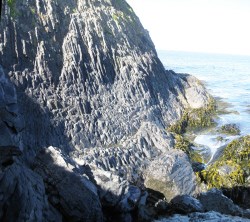 # You will need to wait patiently for a VERY LOW TIDE on a FINE DAY with CALM SEAS before you attempt the route to The Docks and the Roman Baths. Check future tide times, tide heights and predicted swell heights at Metservice - Blackhead surf.
# You will need to wait patiently for a VERY LOW TIDE on a FINE DAY with CALM SEAS before you attempt the route to The Docks and the Roman Baths. Check future tide times, tide heights and predicted swell heights at Metservice - Blackhead surf.
# It takes about half an hour (one way) from the carpark to the Roman Baths. Please start at least an hour before the actual low tide time to give yourself a good margin of safety; plan to be back before the tide starts to turn.
# Look at the WAMS map for a close up view of the route (remove the blue "Hydro" layer).
View from rockfall; The Docks are around the corner
# Go with another person, and let someone know where you are going and what time you expect to be back.
# It would be better to go outside Blackhead Quarry working hours, just in case quarrying causes rockfalls.
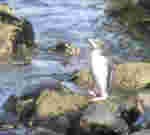 # You may be lucky enough to encounter seals basking on the rocks at the end of the beach, or maybe even a hoiho. If so, give them plenty of space and go around on the landward side.
# You may be lucky enough to encounter seals basking on the rocks at the end of the beach, or maybe even a hoiho. If so, give them plenty of space and go around on the landward side.
# You will cross a major rockslide, at the place where Pi Nut Case was crushed to archive status by falling rocks. Be aware of the possibility of further rockfalls.
# There are large loose rocks at the point where you descend from the rockslide going towards the Docks. Please go down this section separately, to avoid knocking rocks down on each other.
# The route to The Docks and the Roman Baths requires clambering around steep rock faces directly above the waves. The rock is solid and grippy, and there are good hand and footholds all the way so it’s easier than it looks, but you will definitely need to be confident balancing on steep slopes.
# Always keep an eye on the ocean and be aware of the possibility of unexpected large waves.
# We have talked to people who have reached the Roman Baths by walking around the side of the quarry and then scrambling down the hillside. This is private property so please do not follow this route. However, it is worthwhile knowing about in case you need an emergency exit.

BACKGROUND
We've all noticed how dried mud splits into a network of cracks which looks very similar to columnar jointing in rock. Back in the 18th century, many scientists thought that basalt must be a sedimentary rock which cracked into columns as it dried. The influential writer Goethe, a leading Neptunist, proposed that basalt columns were individual crystals, deposited from water in columnar form.
In 1804 Gregory Watt (son of inventor James Watt; he died of TB later that year aged 27) melted basalt rock in a furnace and saw that columns formed as the basalt cooled. Gradually the Plutonist view that rocks were formed by volcanic activity was accepted.
In Dunedin in 1867 the well-known rambler Pakeha (Peter Thompson ) admired the columns at Blackhead (then called “Green Island Peninsula”). His article in the Otago Witness 25 October 1867 says:
RAMBLES ROUND DUNEDIN: GREEN ISLAND PENINSULA
… The base of the hill is composed of a magnificent range of basaltic columns, standing erect, of much larger size than the beds above, quite as complete as those of Fingal's Cave at Staffa, or the Giant's Causeway in Ireland. Indeed, the rocks here are as worthy of a visit as either of these Old Country lions and there is no doubt, were they as well known, they would be equally famed. The photographer, if his chemicals would not be affected by the damp sea air, would find many an effective grouping, which would make most capital pictures during a sou-wester the contrast between the black rocks and the broken water must be very fine, and give plenty of light and shade.
It wasn't until 1875 that Robert Mallet F.R.S. described (preview) how columns formed when a hot lava flow cooled and, as it shrank, cracked apart in a columnar pattern.
A well-informed 1908 visitor to Blackhead photographed the Roman Baths and outlined the latest scientific knowledge about column formation in the Otago Witness 10 June 1908:
BASALT COLUMNS, BLACK HEAD, NEAR DUNEDIN. (See Illustrations.)
[P.S. This is completely irrelevant, but the same issue of the Otago Witness has photos and photos and a report of the first test Match at Carisbrook, 6 June 1908]
 These columns are best seen at the sea level. They can be reached in calm weather at low tide from the extreme north end of the Brighton Beach, though some scrambling is necessary to reach them. Basalt columns have been discovered in nearly all parts of the world, but those of the Giant's Causeway and Cape Raoul [photo] are better known to us than those of other localities. They are to be seen in many places near Dunedin, especially on a peak behind Mount Cargill, at the north head of Otago Harbour, and at Sandymount. In none of these localities, however, have they got the symmetry and regularity of those to be seen at Black Head.
These columns are best seen at the sea level. They can be reached in calm weather at low tide from the extreme north end of the Brighton Beach, though some scrambling is necessary to reach them. Basalt columns have been discovered in nearly all parts of the world, but those of the Giant's Causeway and Cape Raoul [photo] are better known to us than those of other localities. They are to be seen in many places near Dunedin, especially on a peak behind Mount Cargill, at the north head of Otago Harbour, and at Sandymount. In none of these localities, however, have they got the symmetry and regularity of those to be seen at Black Head.
The causes that have resulted in the formation of these columns are well understood. Basalt rock is of volcanic origin, and issued from volcanoes in a molten state. Being relatively fluid, it flowed down the sides of the volcano and accumulated in large pools in depressions near its base. These pools of melted rock gradually cooled down and became solid. As the cooling proceeded the material shrunk or contracted. The tension that this contraction caused was relieved by the formation of crevices, and it is a fact that the tension is most satisfactorily relieved by the formation of a series of vertical crevices intersecting at angles of 120deg. Such a series of crevices separates the rock mass into hexagonal columns. The action is exactly similar to the formation of sun cracks in drying mud, only the shrinkage of mud is caused by the evaporation of some of the water in it, while that of basalt is caused by cooling. 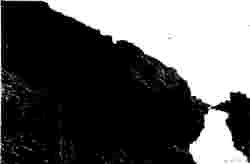 Columnar structure is commoner in basalt than in other volcanic rocks, because it is more fluid than other kinds, and collects in pools before it has time to solidify, while less fluid kinds could not flow so far before they became solid. If a lava solidifies while still in motion, its shrinkage crevices are irregular in size and direction, while if it cools very quickly the crevices are arranged in horizontal series, as in the massive rocks of the Ross Creek quarries. Basaltic columns vary widely in size. Those of Black Head are 6in to a foot in diameter, while those at Sandymount measure 2ft. The size probably depends upon the grain of the rock.
Columnar structure is commoner in basalt than in other volcanic rocks, because it is more fluid than other kinds, and collects in pools before it has time to solidify, while less fluid kinds could not flow so far before they became solid. If a lava solidifies while still in motion, its shrinkage crevices are irregular in size and direction, while if it cools very quickly the crevices are arranged in horizontal series, as in the massive rocks of the Ross Creek quarries. Basaltic columns vary widely in size. Those of Black Head are 6in to a foot in diameter, while those at Sandymount measure 2ft. The size probably depends upon the grain of the rock.
A century later, scientists are still studying the formation of columnar basalt. It's now been shown that there is an "underlying mathematical similarity" between the cracking processes of drying mud and cooling rock.
Basalt columns form in solidifying lava flows or intrusive dykes or sills. They develop at right angles to the cooling surfaces at the margins of the lava flow or magma. The solidifying rock shrinks and pulls apart forming an irregular network of cracks (“contraction joints”).
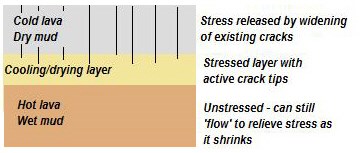 Once each layer of new rock cools to about 750 degrees C, it can’t hold together against the shrinkage stresses. The entire layer suddenly splits apart so that the crack tips advance through to the hot lava below. Each stepwise lengthening of the cracks leaves a small ridge of stone (a “stria”) across the face of the column, showing where the crack tip stopped. The distance apart and alignment of these striae indicate the speed and direction of cooling. Diagram from Goehring's thesis
Once each layer of new rock cools to about 750 degrees C, it can’t hold together against the shrinkage stresses. The entire layer suddenly splits apart so that the crack tips advance through to the hot lava below. Each stepwise lengthening of the cracks leaves a small ridge of stone (a “stria”) across the face of the column, showing where the crack tip stopped. The distance apart and alignment of these striae indicate the speed and direction of cooling. Diagram from Goehring's thesis
For details download the pdf of Dr Lucas Goehring’s doctoral thesis “On the scaling and ordering of columnar joints”.
Goehring shows that the column size, the rate of fracture advance and the rate of cooling are all interdependent. In general, larger columns result from more slowly cooled lavas.
He also points out that the crack network does not evolve toward perfect hexagonal columns as once thought. Rather, the cracks continue to move around as they advance step-wise into the cooling lava, in an unsteady pattern that continues to have a lot of unevenly-shaped columns with different numbers of sides.
BLACKHEAD TODAY:
Blackhead has been quarried since the 1950's, producing crushed rock for railway ballast, roading chip etc from the conveniently jointed basalt. In 1985 Fulton Hogan planned to quarry the centre of the headland down to 50 m below sea level and blast out the northeast side to form a boat harbour. The Friends of Blackhead group formed to protect the headland.
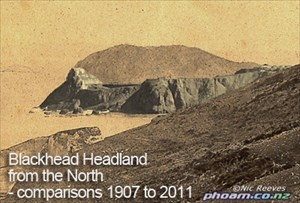 In 1991 the Department of Conservation negotiated a conservation covenant over the western and southern Blackhead coastline. Blackhead Quarries agreed to:
In 1991 the Department of Conservation negotiated a conservation covenant over the western and southern Blackhead coastline. Blackhead Quarries agreed to:
- protect the coastal columnar formations from the effects of quarrying
- allow public access when safe and appropriate
- remove fallen rubble from earlier quarrying
- and restore native vegetation.
A 1994 DOC report Black Head: Vegetation Condition After Quarrying found that rockfall from quarry activities had caused considerable damage to vegetation and chipping of columns on the south facing scree slope. View the original photo at Friends of Blackhead.
Oh, and if you take your olive oil, your strigil and your favourite bath slave to the Roman Baths for a plunge in the frigidarium, we'd love to see the photo in your log...
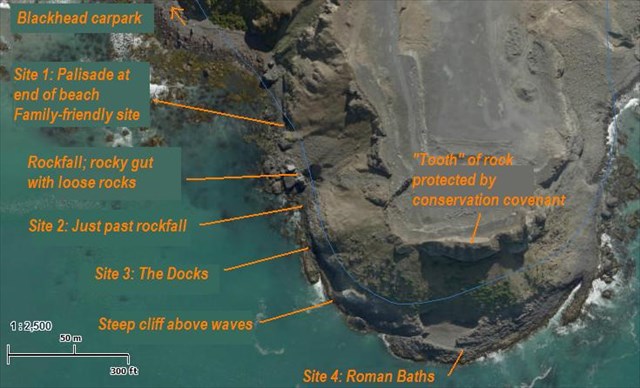
Additional Hints
(Decrypt)
Nyy gur onpxtebhaq vasbezngvba lbh arrq vf va gur pnpur jevgrhc. Rkprcg, 30 pz = 1 sbbg.